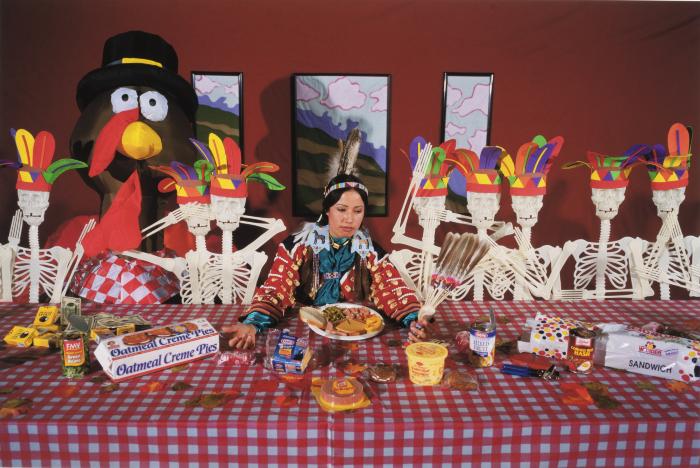As Thanksgiving approaches this week and as our Big Read program comes to an end, we want to share some suggestions and reflections on the first “Thanksgiving Story” that we often hear.
In elementary school, I remember that me and all my classmates were assigned to play the role of either the pilgrims or the Native Americans. We created construction paper hats to reflect which role we were assigned and then wore them while we ate our Thanksgiving feast.
At the time, I didn’t think anything about it. However, after attending many of our Big Read 2021 events and learning from our amazing speakers, I realize how damaging, hurtful, and untrue this version of the historical first Thanksgiving Story is. The story of Thanksgiving makes it seem that the pilgrims and Native Americans existed together peacefully. This wasn’t the case and, there are so many other historically inaccurate ideas embedded in this version of those events.
The Kruizenga Art Museum at Hope College acquired an art piece by Wendy Red Star for our Big Read program (among others) and it specifically addresses Thanksgiving.
In his Big Read gallery talk earlier this month, Charles Mason, curator of the museum reflected on the piece and some of its meanings. below are some of the things he shared with those of us in attendance.
- A self-portrait of Wendy Red Star is the focus of the piece with her wearing the traditional Crow ceremonial costume. Wendy Red Star poses at a table with a group of skeletons wearing dollar-store feather headdresses like the headdresses often made in schools for Thanksgiving. The Kruizenga Art Museum tell us that:
“The skeletons remind us that while Thanksgiving is meant to celebrate the early English colonists’ survival after a difficult first year in a new land, for Native Americans the arrival and survival of European settlers in North America resulted in millions of Native deaths from disease and white violence over the decades and centuries that followed.”
2. A cartoonish inflatable turkey looms behind the table while the tabletop is spread with an array of canned foods, oatmeal creme pies, cigarettes, and more. While some have a turkey and all of the trimmings for Thanksgiving, the foods scattered on the table represent what Wendy Red Star ate for Thanksgiving. The curator, Charles Mason, explained the purpose of this during one of his tours at the Kruizenga Art Museum:
“These visual elements remind us that the legacy of the first Thanksgiving’s abundance has not been passed down equally to everyone, and that many Native Americans continue to suffer disproportionately from poverty and ill-health as a result of having their lands stolen and their cultures suppressed by numerous governments, corporations and individuals over the past 400 years.”
3. The title and the visual aspects of the photograph reference the Last Supper by Leonardo Da Vinci. This references the ties between Christianity and Native Americans. Many religious groups ran boarding schools or attempted to assimilate Native Americans. The description of this painting explains the choice behind this:
“By injecting this reference to an icon of European Christian art, Red Star reminds us that European colonization of the Americas was driven at least partly by the desire to spread Christianity and that many Christian churches and organizations played a shameful role in efforts to suppress Native American culture and force the assimilation of Native American people into mainstream white society during the 19th and 20th centuries.”
If you’d like to see more of the art in the KAM’s Big Read exhibit, go here.
If you’d like to read over some excellent curriculum resources for more accurately and empathetically understanding and talking about the first Thanksgiving story, we recommend materials from the Oklahoma City Public Schools Native American Student Services. You can access them here.
Happy Thanksgiving! May our traditions this year help to “interrupt the cycle of ignorance”, something that Dr. Debbie Reese, one of our Big Read authors, encouraged us to do.
